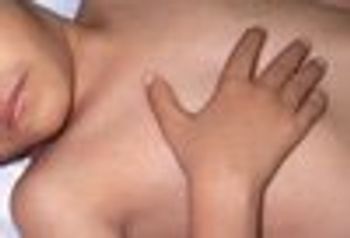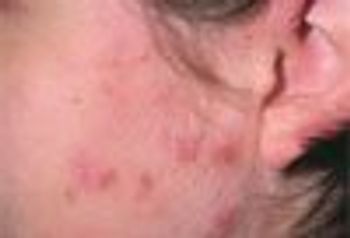
A 4 1/2 year-old Hispanic boy is referred to the pediatric clinic because of failure to thrive and growth retardation. He was born at full-term in Mexico and weighed 1.9 kg at birth (lower than the 3rd percentile).

A 4 1/2 year-old Hispanic boy is referred to the pediatric clinic because of failure to thrive and growth retardation. He was born at full-term in Mexico and weighed 1.9 kg at birth (lower than the 3rd percentile).

This baby boy was born at term to an 18-year-old primigravida via spontaneous vaginal delivery. The membranes ruptured about 6 hours before delivery. The amniotic fluid was heavily stained with meconium. Forceps were not used during the delivery. The newborn initially had poor tone and no spontaneous respirations, but his heart rate exceeded 100 beats per minute. Bulb and deep suctioning as well as supplemental oxygen were provided. Apgar scores were 3 and 8 at 1 and 5 minutes.

The parents of this 1-year-old girl brought her for evaluation of a neck mass of sudden onset (A). They had first noticed the mass on the morning of presentation. The child had cold symptoms and had been snoring, but she had no history of fever, shortness of breath, wheezing, or stridor. Her activity level and appetite had not changed.

A 4-year-old Hispanic boy was referred to our facility because of elevated levels of alanine trans- aminase (ALT) and aspartate transaminase (AST), which were detected during an evaluation of transient abdominal pain while the boy was in Puerto Rico. He was otherwise in perfect health; a review of systems was negative. His past medical history and birth history were noncontributory. Immunizations, including hepatitis B, were up-to-date. The family history was significant for tuberculosis and rheumatoid arthritis.

A 15-year-old girl was brought to the emergency department because of bilateral shoulder and hip pain associated with myalgia and fatigue. The symptoms had been present for 2 months and had increased in intensity over the past few days. The patient had systemic lupus erythematosus, asthma, and seizure disorder.

Transient tachypnea of the newborn (TTN) has traditionally been seen as a benign, self-limited disorder that occurs within a few hours of birth and resolves within 72 hours. For years, we have been telling parents that this innocent condition has no long-lasting effects and is nothing to be concerned about. According to a recent study in The Journal of Pediatrics, however, we may need to rethink that advice.

This happened over 25 years ago, but she remembers it clearly. . . . at the time, she was a pregnant intern on the infant-toddler ward of the busiest children's hospital in the Midwest. It was December, and the ward was jumping. One of her patients, Tony, a 3-month-old with tracheomalacia and severe croup was sick and not improving much. Tony's mother was worried mainly about her son, but there were other things. She had recently come north after being laid off in Alabama. Her unemployment had quickly led to homelessness. She had a brother in town, and she had moved in with him. When she arrived, she found out that he was a heroin addict. He was uninterested in her and her son, and his house was unsafe.

This 6-year-old child was brought to the emergency department by her parents after these blisters suddenly appeared on her skin. She otherwise appeared to be well and was not febrile.

A 16-year-old girl is bothered by a spreading, itchy rash of 1 week’s duration on the left preauricular cheek. The otherwise healthy teenager denies taking any medications or using new cosmetics.

ABSTRACT: Because almost one tenth of American children aged 2 to 11 years have untreated tooth decay, a physical examination that includes inspection of the mouth is crucial. Look for cavitated or noncavitated lesions, dental fillings, and missing teeth; gingivitis and/or plaque, chalky white spots, or deep fissures on the teeth suggest dental decay. Dental care strategies that can be discussed at well-child visits include the benefits of daily flossing and brushing with fluoridated toothpaste, limited intake of dietary sugar, the establishment of a dental home, and use of protective mouthguards and face protectors during sport activities. Fluoride supplementation can be prescribed for children exposed to inadequate amounts in the water supply. The Caries-Risk Assessment Tool can help identify children at high risk for tooth decay. The pediatrician can have a great impact on ensuring that children obtain necessary dental care; a literature review found that children referred to a dentist by a primary care provider were more likely to visit a dentist than those not referred.

I enjoyed the case involving an 8-year-old boy whose hand was bitten by a copperhead snake1 but would point out the following inaccuracies.